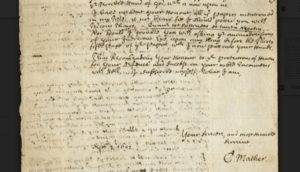Letter from Cotton Mather to William Stoughton, September 2, 1692 facts for kids
In a letter dated September 2, 1692, a famous minister named Cotton Mather wrote to Judge William Stoughton. This letter is very important because it was one of the last major writings from Mather to be found in modern times. Scholars didn't get to see and confirm the original handwritten letter until sometime between 1978 and 1985.
Contents
What the Letter is About
This letter was written during a very difficult time in Salem, Massachusetts. On August 19, 1692, five people accused of witchcraft had been put to death. This brought the total number of executions to eleven, and it would reach twenty by the end of September. Cotton Mather was at one of these executions. Some stories say he even gave a speech from horseback to calm a crowd that was asking for mercy for the accused.
In his letter, Cotton Mather told Judge Stoughton that he was very eager to help stop "devilism" (meaning the witchcraft accusations). He also hinted that he was careful about how he presented his ideas. He asked Stoughton for permission to write about the trials in detail. This makes some people think that Mather's later claim—that the colonial Governor William Phips ordered him to write his book—might not have been entirely true. Governor Phips actually wrote on October 10, 1692, that he "put a stop to the printing of any discourses one way or other."
Along with his letter, Mather sent a big part of a book he had already started writing. He told Stoughton that he could skip the first 34 pages. Historian Stacy Schiff believes that Mather's book was meant to be like a "propaganda piece" (something written to convince people of a certain idea). This is different from how some people in the late 1900s saw the book, which was more as a "defense" of the trials.
Judge Stoughton was very happy with Mather's letter. He even wrote a strong recommendation for Mather's book, called Wonders of the Invisible World, which was printed in the book's introduction. Stoughton specifically suggested that the book should be "committed unto the PRESS" (meaning, printed). Stoughton might have helped Mather get around Governor Phips's order. Mather even thanked Stoughton in the book's introduction for giving him a "shield" to send the book "abroad" to England. The book arrived in England by the end of December and was quickly printed.
One of Mather's main goals, as he wrote in the September 2 letter, was to quickly get copies of the official trial records. But it seems he had trouble getting them. He wrote another letter on September 20, 1692, to Stephen Sewall, the trial clerk, still asking for them. Mather probably didn't get these records until September 22, 1692, when Sewall traveled to Boston to meet with Mather and Stoughton.
Why This Letter is Important
The discovery of the original handwritten letter in the 1980s was a big deal for historians. Before this, many scholars had only seen a typed copy of the letter. Some historians, like Harold Jantz, even thought the typed copy might be a fake! But when the original handwritten letter (called a "holograph") was found, it was confirmed to be real.
This discovery changed how some historians viewed Cotton Mather and his role in the Salem Witch Trials. For example, Kenneth Silverman, who won awards for his biography of Mather, had previously suggested Mather didn't want to defend the trials. The full letter, however, showed Mather's strong desire to be involved and to write about the trials. This meant that some earlier ideas about Mather had to be re-examined.
How the Letter Was Found
The original handwritten letter was sold by the widow of a collector who owned it. It was then bought by Boston College. Experts checked Mather's handwriting and confirmed that the paper was old enough to be from that time.
Another way the letter's authenticity was confirmed was by a line of handwriting from Judge Stoughton himself. He wrote a short note at the top of the letter. This note was also copied onto the old typed version of the letter. Stacy Schiff, a historian, was one of the first to point out this important detail. She also noted that the original letter is kept at the John J. Burns Library of Rare Books and Special Collections at Boston College.
Even though the letter was confirmed as real in the 1980s, it didn't get much attention for a while, even during the 300th anniversary of the trials in 1992. However, more recently, historians like Mary Beth Norton and Clive Holmes have started to pay more attention to the September 2 letter. They see it as a very important document for understanding Cotton Mather's actions and thoughts during the Salem Witch Trials.
Today, you can get digital copies of the letter from both the American Antiquarian Society (which has the old typed copy) and Boston College (which has the original handwritten letter).
Images for kids


